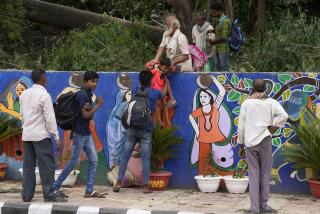G-20 security fence in Seoul draws criticism
- Share via
Reporting from Seoul — The barricade rose under cover of darkness, a mile-long wall of tough polyurethane and bulletproof glass that transformed the nation’s largest mall and convention center into a South Korean version of Fort Apache.
As workers scurried overnight Wednesday to apply the finishing touches, the 7-foot-high security fence surrounding the site of Seoul’s G-20 economic summit resembled something more apt to be seen in repressive North Korea than in one of the planet’s newer democracies.
“We’ll have it up by dawn,” said a worker wearing a yellow hard hat.
The wall encircling the Coex convention and exhibition center in the capital’s fashionable Gangnam district is designed to offer peace of mind to foreign dignitaries converging here for two days of meetings that start Thursday, security officials say.
Similar barriers were set up at economic summits in London, Toronto and Pittsburgh to protect international leaders in the face of frequently violent demonstrations.
Nevertheless, criticism of the barrier is growing. Some call it the Korean peninsula’s newest DMZ, a formidable fence separating the capitalist strategists from those staging the raging rallies outside.
Others liken the wall to a medieval moat or the barriers surrounding Baghdad’s Green Zone.
In a dig at President Lee Myung-bak, newspapers have nicknamed the fence “Myung-bak’s Wall No. 2,” a reference to an earlier fortification of shipping containers used to block protesters during 2008 protests of U.S. beef imports.
“It just sends the wrong message,” said Jang Sung-min, a former national legislator. “It reminds me of our country’s dark days of military dictatorship. It just doesn’t fit today’s South Korea.”
Security workers said they waited until 10 p.m. to erect the structure to reduce the inconvenience to adjacent residents and businesses. Critics counter that officials sought to keep it hidden amid all the feel-good pre-summit hoopla.
“It’s a barrier to keep South Korea outside the conference,” said Seoul G-20 spokeswoman Sohn Jie-ae. “It’s not something security people want to talk about — a necessary evil.”
The wall is actually one of three summit barriers erected here. There is also a “second line” green barbed-wire fence, as well as a “third line.”
Additional security includes anti-terrorism guard posts and a secret state-of-the-art system that one newspaper here said can “detect possible terrorist suspects who have even had plastic surgery to change their faces.”
Moreover, 60,000 security troop will be on hand to help handle the hundreds of activist groups that have applied to stage protests.
Experts point to ample rationale for the tight security.
“ 9/11 changed everything,” said John Kirton, co-director of the G20 Research Group at the University of Toronto’s Munk School of Global Affairs. “These events used to be kinder, gentler affairs where there was little security and dignitaries were accessible.”
As host of the summit, South Korea faces threats from known enemy North Korea but could now be on Al Qaeda’s radar, Kirton said.
“A G-20 meeting is the perfect terrorist target,” he said. “At no other time will attackers know in advance that the world’s leaders will meet in a particular place and time.”
North Korea has ridiculed Seoul’s security concerns, its state-controlled news service calling them “a childish farce.”
Late Wednesday, under stadium-bright lighting, laborers unloaded pieces of the hard plastic base of the fence, which they fitted together like Lego blocks and filled with water before affixing the bullet-proof glass to the top. As each truck pulled away after dumping its load, workers high-fived and then moved on to the next arriving truck.
A Buddhist temple near the summit site lies within the second security fence. After negotiations, security officials allowed worshipers to enter through a back door, despite worries that protesters might storm the building for use as a staging ground.
A temple official, who asked not to be named, said the center would handle its own security but that in “an urgent and tense situation, we will be calling for outside help.”
When the summit closes shop, the man-made wall that helped create an image of a city under siege will face a pedestrian future: It will be broken apart and used as road lane dividers.
Ethan Kim of The Times’ Seoul Bureau contributed to this report.
More to Read
Sign up for Essential California
The most important California stories and recommendations in your inbox every morning.
You may occasionally receive promotional content from the Los Angeles Times.











